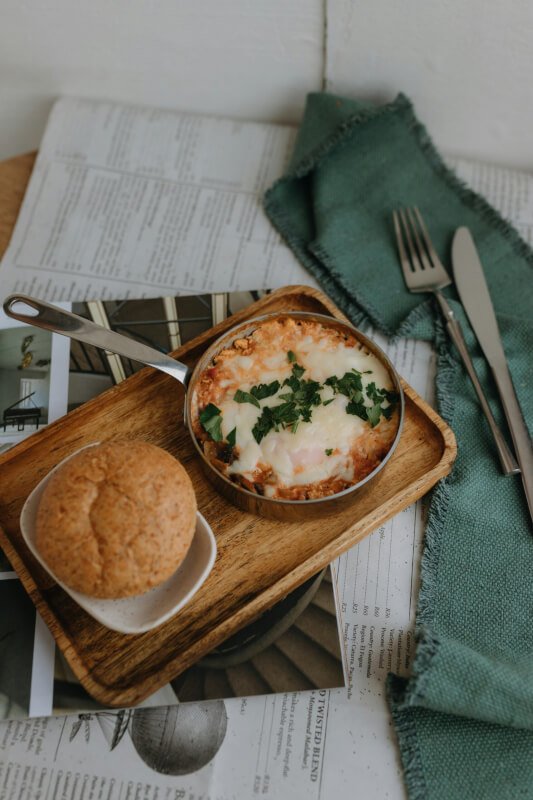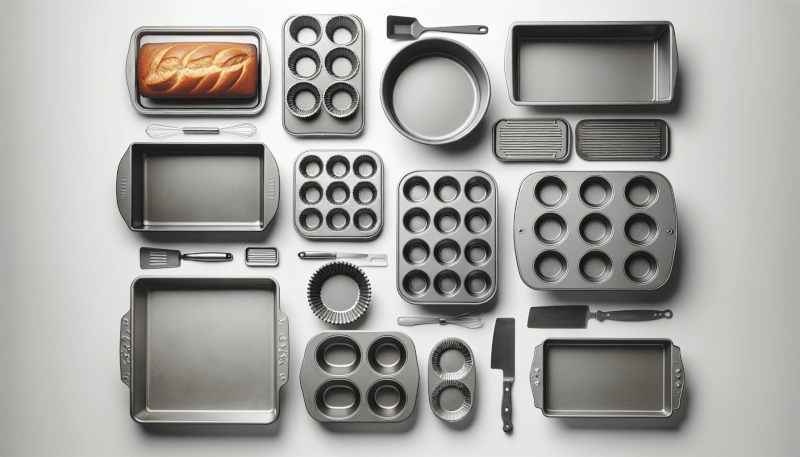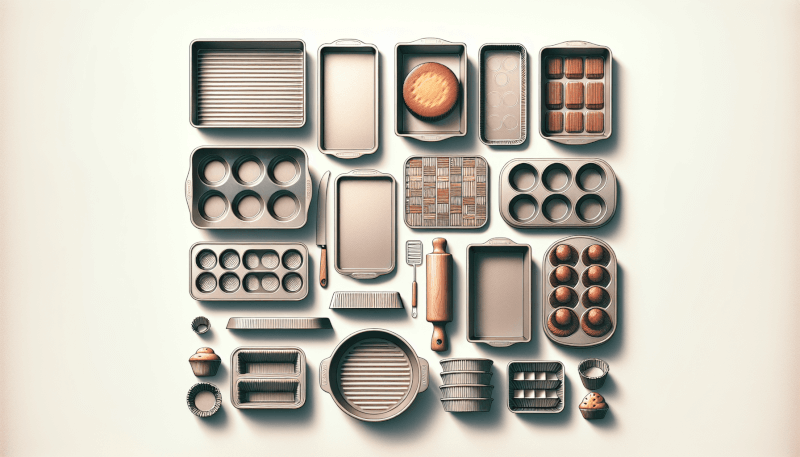Ready to up your baking game? Look no further than this article, where we’ll be comparing different types of baking pans to help you choose the perfect one for your culinary creations. From the classic aluminum pans to the trendy non-stick options, we’ll explore their pros and cons, so you can bake with confidence and achieve mouthwatering results every time. So grab your oven mitts and let’s get started!

1. Introduction to Baking Pans
Baking is a delightful way to create delicious treats and baked goods. But have you ever thought about the important role that baking pans play in achieving baking success? Choosing the right baking pan can greatly impact the final outcome of your baked goods. To help you navigate the world of baking pans, let’s explore the different types available and their unique features.
Importance of choosing the right baking pan
Selecting the appropriate baking pan is crucial for several reasons. Firstly, it ensures even heat distribution during the baking process, resulting in perfectly baked treats. Secondly, the right baking pan can prevent overbrowning or undercooking of your baked goods. Additionally, using the right pan can make the cleaning and maintenance process a breeze. By understanding the different types of baking pans, you can make an informed decision and elevate your baking game to new heights.
Overview of different types of baking pans
There are several types of baking pans available, each with its advantages and disadvantages. Let’s delve into the various types to help you choose the perfect pan for your culinary creations.
2. Traditional Metal Baking Pans
Traditional metal baking pans have been a staple in kitchens for generations. These pans are typically made of aluminum or stainless steel and are known for their durability.
Description of traditional metal baking pans
Traditional metal baking pans come in various shapes and sizes, including round, square, and rectangular. They have a shiny finish and are usually lightweight, making them easy to handle. These pans often have straight sides and may or may not have a non-stick coating.
Advantages of traditional metal baking pans
One of the significant advantages of traditional metal baking pans is their excellent heat conductivity. This property ensures even heat distribution, resulting in evenly baked goods. Metal pans also tend to heat up quickly, reducing overall baking time. Furthermore, these pans are generally affordable and readily available, making them a popular choice for home bakers.
Disadvantages of traditional metal baking pans
Although traditional metal baking pans have many advantages, they do have a few downsides to consider. Without a non-stick coating, food may stick to the surface, making it more challenging to remove and clean the pan. Additionally, metal pans may react with acidic ingredients, altering the taste of your baked goods. It’s also important to note that traditional metal pans are prone to warping and denting if mishandled or subjected to sudden temperature changes.

3. Non-Stick Baking Pans
Non-stick baking pans have gained immense popularity in recent years, thanks to their convenient features and hassle-free baking experience.
Description of non-stick baking pans
Non-stick baking pans are made of metal with a special non-stick coating, usually Teflon or ceramic. This coating prevents food from sticking to the pan, making for easy release and hassle-free cleaning. Non-stick pans come in various shapes and sizes, just like traditional metal pans.
Advantages of non-stick baking pans
The primary advantage of non-stick baking pans is their superior non-stick surface. This attribute ensures that your baked goods effortlessly slide off the pan, leaving minimal residue behind. Non-stick pans also require less oil or butter during baking, resulting in potentially healthier treats. Additionally, these pans are generally more resistant to scratches and staining, ensuring their longevity.
Disadvantages of non-stick baking pans
Non-stick coating can wear off over time, so it’s essential to handle these pans with care to maintain their non-stick qualities. High heat or metal utensils can damage the coating, rendering it less effective. Furthermore, some people have concerns about the potential health risks associated with non-stick coatings when exposed to high temperatures.
4. Glass Baking Pans
Glass baking pans offer a unique alternative to traditional metal pans, bringing their own set of advantages and considerations to the table.
Description of glass baking pans
Glass baking pans are made of tempered glass that can withstand high oven temperatures. They are typically transparent or translucent and come in various shapes and sizes, similar to other types of pans. Glass pans often have a smooth surface and do not have a non-stick coating.
Advantages of glass baking pans
One significant advantage of glass baking pans is their ability to distribute heat evenly. They retain heat well, resulting in a consistent baking temperature throughout the pan. Glass pans are also aesthetically pleasing, allowing you to monitor the browning and progress of your baked goods. Moreover, glass pans are non-reactive, meaning they won’t affect the taste of acidic ingredients like metal pans might.
Disadvantages of glass baking pans
While glass baking pans have many advantages, they also have some drawbacks to consider. Glass is a poor conductor of heat, meaning it takes longer for the pan to heat up. This extended heating time can increase overall baking time, which may not be ideal for recipes with strict timings. Glass pans are also relatively fragile compared to metal pans and are more prone to breaking if mishandled or subjected to sudden temperature changes.

5. Silicone Baking Pans
Silicone baking pans have gained popularity in recent years due to their flexibility and convenience.
Description of silicone baking pans
Silicone baking pans are made of food-grade silicone, a flexible and heat-resistant material. These pans come in various shapes and sizes, including muffin molds, loaf pans, and cake pans. The flexible nature of silicone allows for easy removal of baked goods without the need for greasing or flouring.
Advantages of silicone baking pans
Silicone pans offer effortless food release, ensuring your baked goods easily pop out without sticking to the pan. They require no additional oil or grease, promoting healthier baking. Silicone pans are also extremely easy to clean, as they can be quickly washed by hand or placed in the dishwasher. Additionally, silicone is a non-reactive material that won’t affect the taste or color of your baked goods.
Disadvantages of silicone baking pans
One disadvantage of silicone baking pans is their tendency to retain odors from certain foods. This means that strong-smelling ingredients like garlic or spices may leave a residual scent on the pan. Additionally, silicone pans can be challenging to handle when filled with batter, as they lack the rigidity of traditional metal or glass pans.
6. Ceramic Baking Pans
Ceramic baking pans offer a beautiful and versatile option for baking enthusiasts who appreciate aesthetics and functionality.
Description of ceramic baking pans
Ceramic baking pans are made from clay that is fired at high temperatures to create a durable and heat-resistant product. These pans come in various shapes, sizes, and vibrant colors, making them perfect for both baking and serving. Ceramic pans often have a glazed finish, which provides a non-stick surface.
Advantages of ceramic baking pans
Ceramic pans are known for their aesthetic appeal, enhancing the presentation of your baked goods. They offer excellent heat distribution, resulting in even baking. Additionally, ceramic pans retain heat well, keeping your dishes warm for longer. The glazed finish also ensures easy food release and quick cleanup.
Disadvantages of ceramic baking pans
Ceramic baking pans can be more fragile compared to metal pans, requiring careful handling to avoid cracks or breaks. It’s also important to note that while the glaze provides a non-stick surface, it may wear off over time, affecting the pan’s performance. Ceramic pans may also take longer to heat up compared to metal pans.

7. Cast Iron Baking Pans
Cast iron baking pans are a classic option, known for their excellent heat retention and durability.
Description of cast iron baking pans
Cast iron baking pans are made from molten iron that is poured into a mold and seasoned with oil. These pans are heavy, durable, and often feature a rough, textured cooking surface. Cast iron pans come in various shapes and sizes, including skillets, baking dishes, and Dutch ovens.
Advantages of cast iron baking pans
One of the main advantages of cast iron baking pans is their exceptional heat retention. These pans heat up slowly but retain the heat well, ensuring even baking throughout. Cast iron pans can also be used on stovetops or in the oven, making them versatile for different cooking methods. With proper care, cast iron pans can last for generations, making them a worthwhile investment for any baking enthusiast.
Disadvantages of cast iron baking pans
The weight of cast iron pans can make them challenging to handle, especially when filled with batter or when transferring from the oven. Additionally, cast iron pans require regular maintenance and seasoning to maintain their non-stick surface and prevent rusting. They also tend to take longer to heat up compared to other types of pans.
8. Copper Baking Pans
Copper baking pans offer a luxurious and professional touch to your baking endeavors, with their excellent heat conductivity and stunning appearance.
Description of copper baking pans
Copper baking pans are made from copper or have a copper core surrounded by other materials like stainless steel. These pans often feature a shiny, metallic exterior and a smooth interior surface. Copper pans come in various shapes and sizes, catering to different baking needs.
Advantages of copper baking pans
Copper pans excel in heat conductivity, distributing heat evenly throughout the pan and promoting precise baking. The quick response to temperature changes allows for greater control over your baking process. Copper pans also have a beautiful appearance, perfect for showcasing your culinary creations. Additionally, copper is antimicrobial, making it a hygienic choice for baking.
Disadvantages of copper baking pans
One significant disadvantage of copper baking pans is their high cost compared to other types of pans. Copper pans also require regular maintenance to retain their shine and avoid tarnishing. Copper can react with certain foods, resulting in a metallic taste if the pan is not properly lined or coated.

9. Choosing the Right Baking Pan for Specific Recipes
When it comes to selecting the right baking pan for your recipes, there are a few considerations to keep in mind.
Considerations for selecting the right pan
Firstly, determine the size and shape required by the recipe. Consider the volume of batter or dough and select a pan that allows for proper rising and spreading during baking. Additionally, take note of the desired texture or crispness of the finished product. Some recipes may call for a specific type of pan to achieve the desired outcome.
Match pan types to recipe requirements
For example, if you want a crispy crust, a metal or glass pan is a good choice as they provide excellent heat transfer. For delicate cakes or dishes with acidic ingredients, non-reactive pans like glass or ceramic are ideal. For recipes that require precise temperature control or browning, copper or cast iron pans offer superior performance.
10. Conclusion
In conclusion, choosing the right baking pan is essential for achieving the desired results in your baking endeavors. Traditional metal pans offer excellent heat conductivity but may require additional greasing and careful handling. Non-stick pans provide convenience and easy cleanup but may require careful maintenance. Glass pans offer even baking and a clear view of the progress, but they may take longer to heat up. Silicone pans provide effortless food release but can retain odors. Ceramic pans are aesthetically pleasing but may be more fragile. Cast iron pans are durable but heavy and require maintenance. Lastly, copper pans offer professional heat conductivity but come at a higher cost.
By understanding the unique features and considerations of each type of baking pan, you can select the perfect pan to elevate your baking creations. Ultimately, by choosing the appropriate pan, you can create irresistible treats that will delight your taste buds and those of your loved ones. Happy baking!


